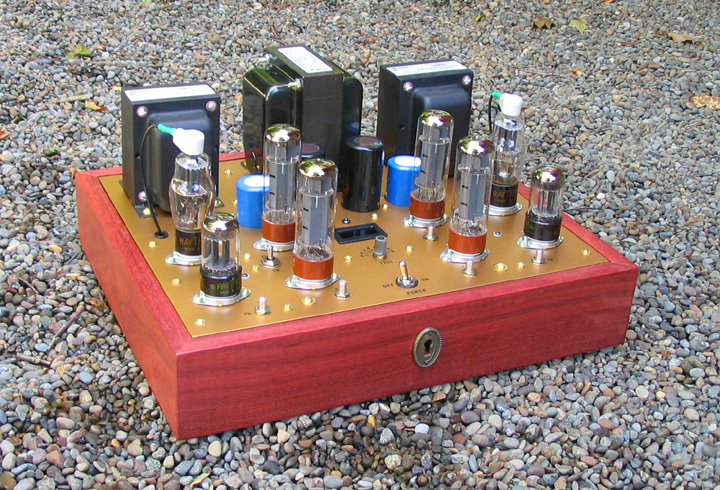Your Legal Resource
Bobs Hi-fi Tube Amp Page
The Musicbox Stereo Hi-Fi tube poweramp
by Robert B. Richards 2-08
Why tubes?
First, let me say that the audible difference between tubes and transistors is pretty small unless a particular design is flawed somehow. I actually do most of my Hi-Fi system with transistors and lots of them. I like to use 4th order active crossovers and a 4 section Baxandall (variable slope) tone control circuit I developed, and occasionally even a variation of the Bob Carver Holographic Generator and/or some variation of a surround sound decoder. My main system has five speaker boxes forming a half-circle variation of surround sound. There's a total of 12 power amps. Trying to do all of that with tubes would take a huge amount of space and draw a lot of current pushing the electric bill up significantly and heating the house too much in the summer. In a guitar amp, it's very clear to me that tubes sound better. In a Hi-Fi the difference to my ears is small, and getting speakers to perform at their best and having good tone controls is more important to me than the difference between tube sound and the sound of a well-designed and properly compensated transistor amplifier. Since I have a very good understanding of how phase margin works, how to design it, and how to actually test it on the bench, I'm not afraid of transistors. Having said all that, here's what my research came up with about tubes.
Most people know that tube amps clip (overdrive) in a more gradual way that is less audible, compared to any transistor circuits. Virtually all-transistor circuits clip (overdrive) with very abrupt, sharp corners, which is significantly more audible.
When run at a level where clipping never occurs, there are other arguments. According to my studies, the best tube sound appears to happen when there's very little feedback, and the circuit topology is either single-ended or slightly un-balanced push-pull. It's all about the harmonic distortion spectrum shape. Feedback causes the distortion products to extend significantly further out from the fundamental (not good unless you like "fizzle", although these distortion products are extremely low in amplitude in a well designed not-overdriven circuit), and a precisely balanced circuit will generate only odd harmonics, which don't have as good a sound like the more natural-sounding "whole" distortion generation (roughly equal amounts of even and odd harmonics distortion products, with the second harmonic dominating). Distortions that could be called "whole" or natural, are less damaging to the sense of reality than distortions that create a less natural "colored" distortion spectrum shape.
This amplifier is an example of both the single-ended concept in the front end and a strategically unbalanced differential amp driving a push-pull output stage. The only feedback is ultra-linear local feedback in the push-pull output stage (unless Triode Mode is selected), and variable partial loop feedback (zero to 15dB) that goes from the output to the diff amp that drives the push-pull output stage. The front end-stage is outside of any feedback loop at all times, so its almost perfect harmonic distortion spectrum shape is left untainted. The slightly unbalanced (about 1dB) drive to the push-pull output section creates a distortion spectrum shape that is very similar to that of the front-end single-ended triode when there's no feedback. When the loop feedback is turned up thereby reducing amplifier output impedance (generally desirable), higher-order (less desirable) harmonics become more significant, in the output section only, but the second harmonic distortion product still dominates.
The Musicbox Amp:
After researching, designing, and building several guitar amps, and collaborating with Matt Kamna, one of the great "Tube Gurus" of our time, I felt I had really gotten inside what brings out the best in a tube, and in amplification in general. At that point, I felt compelled to design a truly excellent tube Hi-Fi amp as well, since most of my audio engineering knowledge has always been about Hi-Fi. I looked at and analyzed dozens of different tube amp schematics that I found on the web. I played with many different topologies, crunching numbers, collaborating with Matt, and learning the problems with each design as I went along. After sucking in all the info I could find, I asked my brain to come up with the ultimate version of a Dynaco Stereo 70 amp, that would be practical, affordable, and have the magic of tubes in its sound signature. Here's what I came up with:
PIC 1 HERE
Stereo. No fully global feedback (so better phase margin).
Built-in digital meter for setting output tube bias (quiescent current).
Variable limited-route feedback 0-15dB.
PIC 2 HERE
30 watts RMS per channel Ultralinear mode/ 16 watts RMS in Triode mode (into 8 ohms).
PIC 3 HERE
Best possible distortion spectrum shape.
To skip to the circuit diagram and calculations, click here.
To skip to test results of the virtually finished amp (are homebrews ever really finished?), click here.
For more photos and much discussion on the circuit development and building process (my original webpage) click here.
